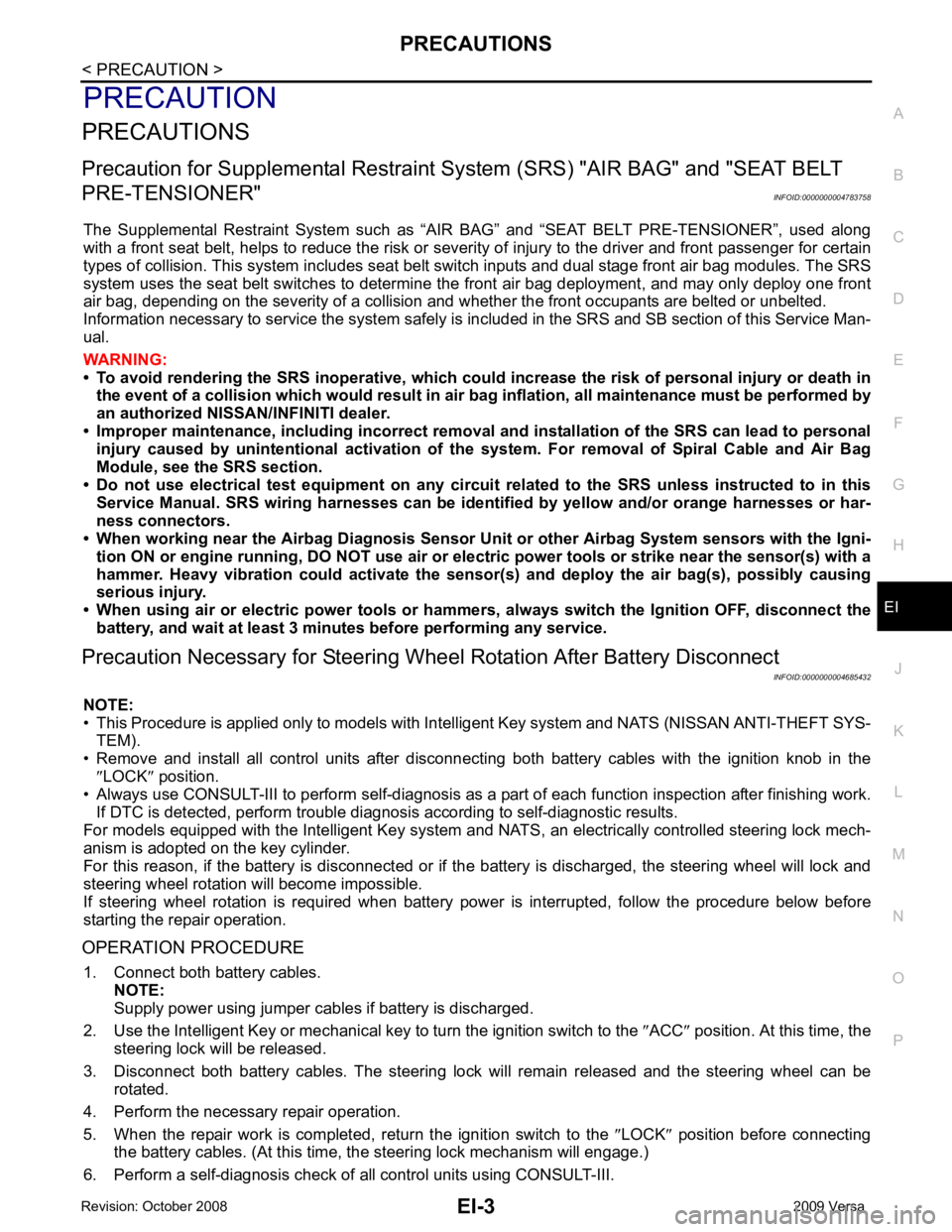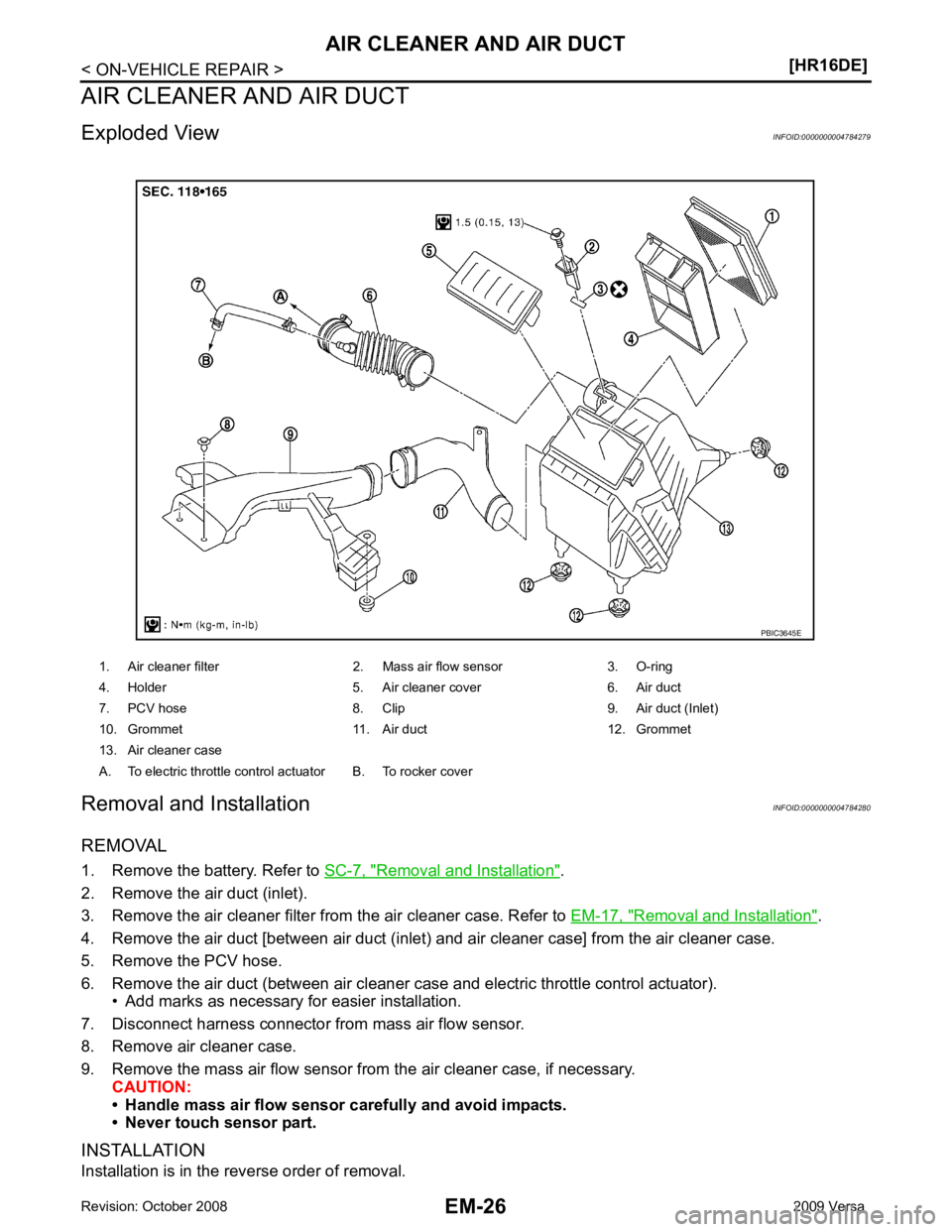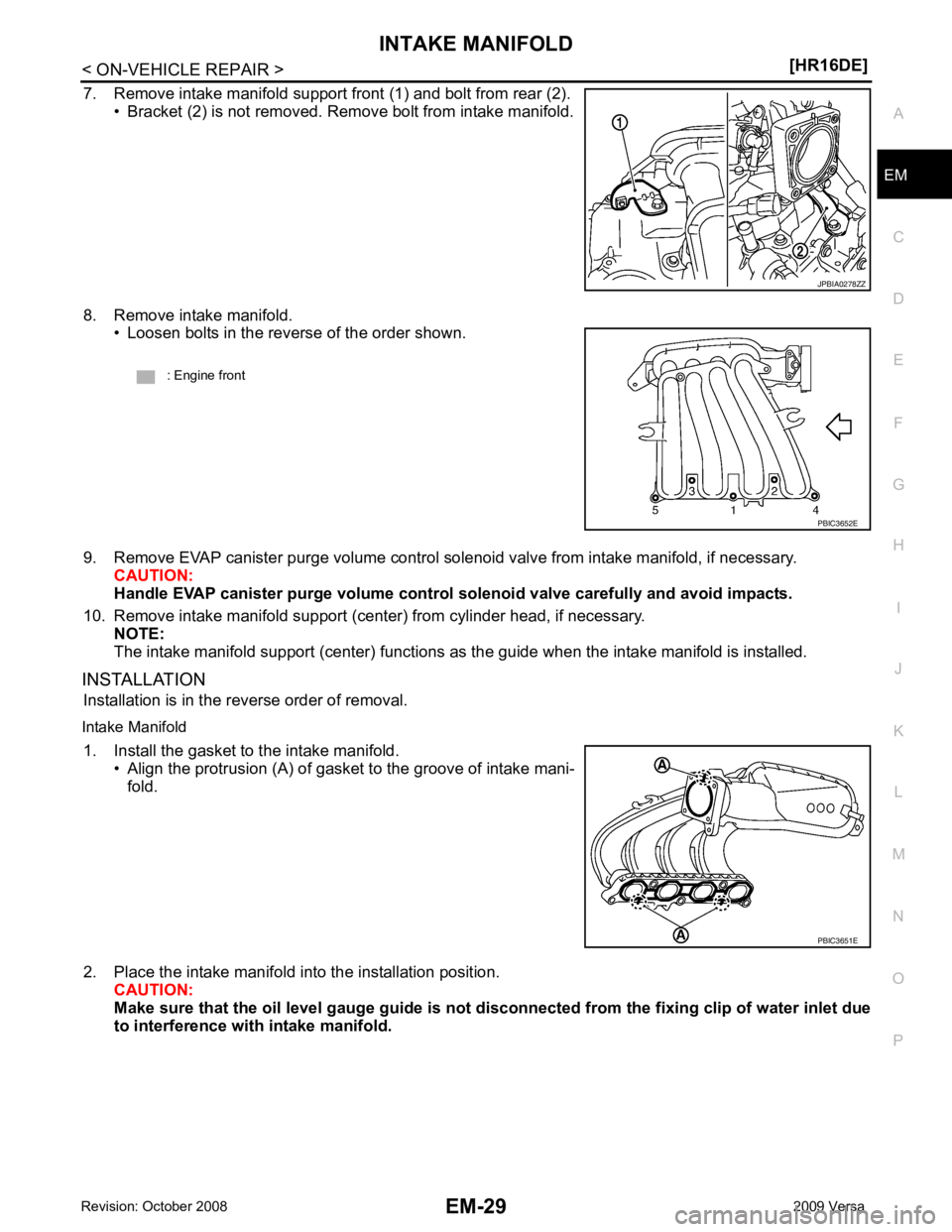Page 2891 of 4331
EC
NP
O
Air Fuel Ratio (A/F) Sensor 1 Heater
INFOID:0000000004500437
Heated Oxygen sensor 2 Heater INFOID:0000000004500438
Crankshaft Position Sensor (POS) INFOID:0000000004500439
Refer to EC-1298, " Component Inspection " .
Camshaft Position Sensor (PHASE) INFOID:0000000004500440
Refer to EC-1303, " Component Inspection " .
Throttle Control Motor INFOID:0000000004500441
Fuel Injector INFOID:0000000004500442
Fuel Pump INFOID:0000000004500443
Resistance [at 25
°C (77 °F)] 1.8 - 2.44 Ω
Page 2894 of 4331

EI
N
O P
PRECAUTION
PRECAUTIONS
Precaution for Supplemental Restraint System (SRS) "AIR BAG" and "SEAT BELT
PRE-TENSIONER" INFOID:0000000004783758
The Supplemental Restraint System such as “A IR BAG” and “SEAT BELT PRE-TENSIONER”, used along
with a front seat belt, helps to reduce the risk or severi ty of injury to the driver and front passenger for certain
types of collision. This system includes seat belt switch inputs and dual stage front air bag modules. The SRS
system uses the seat belt switches to determine the front air bag deployment, and may only deploy one front
air bag, depending on the severity of a collision and w hether the front occupants are belted or unbelted.
Information necessary to service the system safely is included in the SRS and SB section of this Service Man-
ual.
WARNING:
• To avoid rendering the SRS inoper ative, which could increase the risk of personal injury or death in
the event of a collision which would result in air bag inflation, all maintenance must be performed by
an authorized NISSAN/INFINITI dealer.
• Improper maintenance, including in correct removal and installation of the SRS can lead to personal
injury caused by unintentional act ivation of the system. For removal of Spiral Cable and Air Bag
Module, see the SRS section.
• Do not use electrical test equipm ent on any circuit related to the SRS unless instructed to in this
Service Manual. SRS wiring harnesses can be identi fied by yellow and/or orange harnesses or har-
ness connectors.
• When working near the Airbag Diagnosis Sensor Un it or other Airbag System sensors with the Igni-
tion ON or engine running, DO NOT use air or el ectric power tools or strike near the sensor(s) with a
hammer. Heavy vibration could activate the sensor( s) and deploy the air bag(s), possibly causing
serious injury.
• When using air or electric power tools or hammers , always switch the Ignition OFF, disconnect the
battery, and wait at least 3 minutes before performing any service.
Precaution Necessary for Steering Wh eel Rotation After Battery Disconnect
INFOID:0000000004685432
NOTE:
• This Procedure is applied only to models with Inte lligent Key system and NATS (NISSAN ANTI-THEFT SYS-
TEM).
• Remove and install all control units after disconnecti ng both battery cables with the ignition knob in the
″ LOCK ″ position.
• Always use CONSULT-III to perform self-diagnosis as a part of each function inspection after finishing work.
If DTC is detected, perform trouble diagnosis according to self-diagnostic results.
For models equipped with the Intelligent Key system and NATS , an electrically controlled steering lock mech-
anism is adopted on the key cylinder.
For this reason, if the battery is disconnected or if the battery is discharged, the steering wheel will lock and
steering wheel rotation will become impossible.
If steering wheel rotation is required when battery pow er is interrupted, follow the procedure below before
starting the repair operation.
OPERATION PROCEDURE 1. Connect both battery cables. NOTE:
Supply power using jumper cables if battery is discharged.
2. Use the Intelligent Key or mechanical key to turn the ignition switch to the ″ACC ″ position. At this time, the
steering lock will be released.
3. Disconnect both battery cables. The steering lock will remain released and the steering wheel can be
rotated.
4. Perform the necessary repair operation.
5. When the repair work is completed, return the ignition switch to the ″LOCK ″ position before connecting
the battery cables. (At this time, the steering lock mechanism will engage.)
6. Perform a self-diagnosis check of al l control units using CONSULT-III.
Page 2952 of 4331
![NISSAN TIIDA 2009 Service Repair Manual PRECAUTIONS
EM-5
< PRECAUTION >
[HR16DE] C
D E
F
G H
I
J
K L
M A EM
NP
O
5. When the repair work is completed, return the ignition switch to the
″LOCK ″ position before connecting
t NISSAN TIIDA 2009 Service Repair Manual PRECAUTIONS
EM-5
< PRECAUTION >
[HR16DE] C
D E
F
G H
I
J
K L
M A EM
NP
O
5. When the repair work is completed, return the ignition switch to the
″LOCK ″ position before connecting
t](/manual-img/5/57398/w960_57398-2951.png)
PRECAUTIONS
EM-5
< PRECAUTION >
[HR16DE] C
D E
F
G H
I
J
K L
M A EM
NP
O
5. When the repair work is completed, return the ignition switch to the
″LOCK ″ position before connecting
the battery cables. (At this time, the steering lock mechanism will engage.)
6. Perform a self-diagnosis check of al l control units using CONSULT-III.
Precaution for Procedur e without Cowl Top Cover INFOID:0000000004784258
When performing the procedure after removing cowl top cover, cover
the lower end of windshield.
Precaution for Drain Coolant INFOID:0000000004784260
• Drain coolant when engine is cooled.
Precaution for Disco nnecting Fuel Piping INFOID:0000000004784261
• Before starting work, make sure no fire or spark producing items are in the work area.
• Release fuel pressure before disassembly.
• After disconnecting pipes, plug openings to stop fuel leakage.
Precaution for Removal and Disassembly INFOID:0000000004784262
• When instructed to use special service tools, use the spec ified tools. Always be careful to work safely, avoid
forceful or uninstructed operations.
• Exercise maximum care to avoid damage to mating or sliding surfaces.
• Cover openings of engine system with tape or the equiva lent, if necessary, to seal out foreign materials.
• Mark and arrange disassembly parts in an organized way for easy troubleshooting and assembly.
• When loosening nuts and bolts, as a basic rule, start with the one furthest outside, then the one diagonally opposite, and so on. If the order of loosening is specif ied, do exactly as specified. Power tools may be used
where noted in the step.
Precaution for Inspection, Repair and Replacement INFOID:0000000004784263
• Before repairing or replacing, thoroughly inspect parts. Inspect new replacement parts in the same way, and
replace if necessary.
Precaution for Assembly and Installation INFOID:0000000004784264
• Use torque wrench to tighten bolts or nuts to specification.
• When tightening nuts and bolts, as a basic rule, equally tighten in several different steps starting with the ones in center, then ones on inside and outside diagonally in this order. If the order of tightening is specified,
do exactly as specified.
• Replace with new gasket, packing, oil seal or O-ring.
• Thoroughly wash, clean, and air-blow each part. Carefully check oil or coolant passages for any restriction
and blockage.
• Avoid damaging sliding or mating surfaces. Completely remove foreign materials such as cloth lint or dust. Before assembly, oil sliding surfaces well.
• Release air within route after draining coolant.
• Before starting engine, apply fuel pressure to fuel lines with turning ignition switch ON (with engine stopped). Then make sure that there are no leaks at fuel line connections.
• After repairing, start engine and increase engine speed to check coolant, fuel, oil, and exhaust systems for leakage. PIIB3706J
Page 2973 of 4331

Removal and Installation " .
2. Remove the air duct (inlet).
3. Remove the air cleaner filter from the air cleaner case. Refer to EM-17, " Removal and Installation " .
4. Remove the air duct [between air duct (inlet) and air cleaner case] from the air cleaner case.
5. Remove the PCV hose.
6. Remove the air duct (between air cleaner case and electric throttle control actuator). • Add marks as necessary for easier installation.
7. Disconnect harness connector from mass air flow sensor.
8. Remove air cleaner case.
9. Remove the mass air flow sensor from the air cleaner case, if necessary. CAUTION:
• Handle mass air flow sensor carefully and avoid impacts.
• Never touch sensor part.
INSTALLATION
Installation is in the reverse order of removal. 1. Air cleaner filter 2. Mass air flow sensor 3. O-ring
4. Holder 5. Air cleaner cover 6. Air duct
7. PCV hose 8. Clip 9. Air duct (Inlet)
10. Grommet 11. Air duct 12. Grommet
13. Air cleaner case
A. To electric throttle control actuator B. To rocker cover
Page 2975 of 4331
Exploded View " .
2. Remove the reservoir tank. Refer to CO-16, " Component " .
3. Remove the oil level gauge. CAUTION:
Cover the oil level gauge gu ide openings to avoid entry of foreign materials.
4. Remove electric throttle control actuator and position aside. CAUTION:
• Handle electric throttle control act uator carefully and avoid impacts.
• Never disassemble or adjust elect ric throttle control actuator.
5. Disconnect the harness connector and EVAP hose from the EVAP canister purge volume control solenoid
valve.
6. Disconnect vacuum hose for brake booster from intake manifold.
Page 2976 of 4331

EM
NP
O
7. Remove intake manifold support front (1) and bolt from rear (2).
• Bracket (2) is not removed. Remove bolt from intake manifold.
8. Remove intake manifold. • Loosen bolts in the reverse of the order shown.
9. Remove EVAP canister purge volume control solenoid valve from intake manifold, if necessary. CAUTION:
Handle EVAP canister purge volume control solenoid valve carefully and avoid impacts.
10. Remove intake manifold support (center) from cylinder head, if necessary. NOTE:
The intake manifold support (center) functions as the guide when the intake manifold is installed.
INSTALLATION Installation is in the reverse order of removal.
Intake Manifold 1. Install the gasket to the intake manifold. • Align the protrusion (A) of gasket to the groove of intake mani-fold.
2. Place the intake manifold into the installation position. CAUTION:
Make sure that the oil level gauge guide is not disconnected from the fixing clip of water inlet due
to interference with intake manifold.
Page 2977 of 4331
THROTTLE VALVE CLOSED POSITION LEARNING : Special
Repair Requirement " .
• Perform “Throttle Valve Closed Position Learning” and “Idle Air Volume Learning” after repair when replacing electric throttle control actuator. Refer to EC-31, " THROTTLE VALVE CLOSED
POSITION LEARNING :Special Repair Requirement " and
EC-32, " IDLE AIR VOLUME LEARNING : Special Repair Requirement " .
: Engine front
Page 3005 of 4331
Rotation " .
2. Remove front fender protector (RH). Refer to EI-24, " Removal and Installation " .
3. Drain engine oil. Refer to LU-8, " Draining " .
CAUTION:
Be sure to perform this step when engine is cold.
4. Remove the following parts. • Intake manifold: Refer to EM-28, " Exploded View " .
• Drive belt: Refer to EM-15, " Removal and Installation " .
• Water pump pulley: Refer to CO-20, " Exploded View " .
• Ground cable (RH)
1. Camshaft bracket (No. 2 to 5) 2. Camshaft bracket (No.1) 3. Camshaft sprocket (EXH)
4. Camshaft sprocket (INT) 5. Cylinder head 6. Oil filter (for intake valve timing control)
7. Washer 8. Plug 9. Intake valve timing control solenoid valve
10. O-ring 11. O-ring 12. Camshaf t position sensor (PHASE)
13. Valve lifter 14. Camshaft (INT) 15. Camshaft (EXH)
A. Refer to Installation procedure